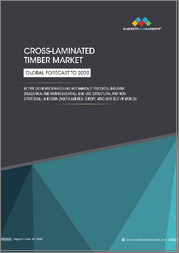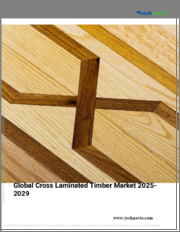
|
시장보고서
상품코드
1615010
세계의 크로스 라미네이티드 팀버(CLT) 시장 - 규모, 점유율, 성장 분석 : 유형별, 최종 용도별, 업계별, 지역별 산업 예측(2024-2031년)Cross Laminated Timber Market Size, Share, Growth Analysis, By Type, By End Use, By Industry, By Region - Industry Forecast 2024-2031 |
||||||
세계 크로스 라미네이티드 팀버(CLT) 시장 규모는 2022년 11억 2,000만 달러로 평가되었고, 2023년 12억 7,000만 달러에서 2031년에는 35억 9,000만 달러로 성장하며 예측 기간(2024-2031년) CAGR은 13.80%로 나타날 전망입니다.
크로스 라미네이티드 팀버(CLT)는 XLam으로도 알려진 인공 목재 제품으로, 집합 주택 및 상업시설 건설에서 기존 철골과 콘크리트를 대체 할 수있는 지속 가능한 선택 대안으로서 급속하게 보급되고 있습니다. 특히 아시아태평양과 북미에서 인기가 높아져 최소한의 노력으로 하루에 최대 1만 4,000평방피트를 현장에서 신속하게 조립할 수 있습니다. 내진 성능, 뛰어난 차음성 및 단열성으로 CLT의 매력이 더욱 늘어나 세계 현대적인 건축 관행에서 선호되는 옵션으로서 CLT의 지위는 확고한 것이 되고 있습니다.
목차
소개
- 조사의 목적
- 조사 범위
- 정의
조사 방법
- 정보 조달
- 2차/1차 정보원
- 시장 규모 예측
- 시장의 전제조건과 제한
주요 요약
- 세계 시장 전망
- 공급과 수요 동향 분석
- 부문별 기회 분석
시장 역학과 전망
- 시장 개요
- 시장 규모
- 시장 역학
- 성장 촉진요인과 기회
- 성장 억제요인과 과제
- Porter's Five Forces 분석과 영향
- 경쟁 기업간 경쟁 관계
- 대체품의 위협
- 구매자의 협상력
- 신규 진입업자의 위협
- 공급기업의 협상력
주요 시장 인사이트
- 중요성공요인
- 경쟁도
- 주요 투자 기회
- 시장 생태계
- 시장의 매력 지수(2023년)
- PESTEL 분석
- 거시경제지표
- 밸류체인 분석
- 가격 분석
- 기술의 진보
- 규제 상황
- 특허 분석
- 사례 연구
- 고객 및 구매 기준 분석
크로스 라미네이티드 팀버(CLT) 시장 규모 : 유형별, CAGR(2024-2031년)
- 시장 개요
- 접착제 접합
- 폴리우레탄(PUR)
- 멜라민 우레아 포름알데히드(MUF)
- 기계적 고정
- 셀프 태핑 나사(STS)
- 다보형 패스너
크로스 라미네이티드 팀버(CLT) 시장 규모 : 최종 용도별, CAGR(2024-2031년)
- 시장 개요
- 구조용
- 비구조용
크로스 라미네이티드 팀버(CLT) 시장 규모 : 업계별, CAGR(2024-2031년)
- 시장 개요
- 주택
- 비주택
- 공공
- 산업
- 기타
크로스 라미네이티드 팀버(CLT) 시장 규모, CAGR(2024-2031년)
- 북미
- 미국
- 캐나다
- 유럽
- 영국
- 독일
- 스페인
- 프랑스
- 이탈리아
- 기타 유럽
- 아시아태평양
- 중국
- 인도
- 일본
- 한국
- 기타 아시아태평양
- 라틴아메리카
- 브라질
- 기타 라틴아메리카
- 중동 및 아프리카
- GCC 국가
- 남아프리카
- 기타 중동 및 아프리카
경쟁 정보
- 상위 5개사 비교
- 주요 기업의 시장 포지셔닝(2023년)
- 주요 시장 기업이 채용한 전략
- 시장의 최근 동향
- 기업의 시장 점유율 분석(2023년)
- 주요 기업 프로파일
- 기업 개요
- 제품 포트폴리오 분석
- 부문별 점유율 분석
- 수익의 전년대비의 비교(2021-2023년)
주요 기업 프로파일
- Mayr-Melnhof Holz
- Stora Enso
- Binderholz GmbH
- Eugen Decker Holzindustrie KG
- Hasslacher Holding GmbH
- Schilliger Holz AG
- KLH Massivholz GmbH
- Structurlam Mass Timber Corporation
- Xlam NZ Limited
- Pfeifer Holding GmbH
- Lion Lumber
- SmartLam NA
- Hoisko
- B&K Structures Ltd
- Theurl Austrian Premium Timber
- IB EWP Inc
- Nordic Structures
- DR Johnson Lumber Company
- Derix Group
- Urbem
- Mercer Mass Timber
결론과 권장사항
JHS 25.01.09Global Cross Laminated Timber Market size was valued at USD 1.12 billion in 2022 and is poised to grow from USD 1.27 billion in 2023 to USD 3.59 billion by 2031, growing at a CAGR of 13.80% during the forecast period (2024-2031).
Cross Laminated Timber (CLT), also known as XLam, is an engineered wood product that is rapidly gaining traction as a sustainable alternative to traditional steel and concrete in multi-residential and commercial construction. Developed in the early 1990s in Europe, CLT boasts a solid wood composition formed by layering and adhesively bonding timber at cross-angles. Its increasing popularity, especially in the Asia Pacific and North America, is driven by its mechanical properties, dimensional stability, and rigidity, allowing for quick on-site assembly of up to 14,000 square feet per day with minimal labor. Enhanced design flexibility, superior seismic performance, and excellent acoustic and thermal insulation further augment its appeal, solidifying CLT's position as a preferred choice in contemporary construction practices worldwide.
Top-down and bottom-up approaches were used to estimate and validate the size of the Global Cross Laminated Timber market and to estimate the size of various other dependent submarkets. The research methodology used to estimate the market size includes the following details: The key players in the market were identified through secondary research, and their market shares in the respective regions were determined through primary and secondary research. This entire procedure includes the study of the annual and financial reports of the top market players and extensive interviews for key insights from industry leaders such as CEOs, VPs, directors, and marketing executives. All percentage shares split, and breakdowns were determined using secondary sources and verified through Primary sources. All possible parameters that affect the markets covered in this research study have been accounted for, viewed in extensive detail, verified through primary research, and analyzed to get the final quantitative and qualitative data.
Global Cross Laminated Timber Market Segmental Analysis
Global Cross Laminated Timber Market is segmented by Type, End Use, Industry, and Region. Based on Type, the market is segmented into Adhesive Bonded, and Mechanically Fastened. Based on End Use, the market is segmented into Structural, and Non-structural. Based on Industry, the market is segmented into Residential, and Non-residential. Based on Region, the market is segmented into North America, Europe, Asia Pacific, Latin America and Middle East & Africa.
Driver of the Global Cross Laminated Timber Market
The global Cross Laminated Timber market is experiencing significant growth due to rapid urbanization, particularly in the Asia Pacific region where there is a noticeable migration from rural areas to urban centers. This demographic shift is driving infrastructure development, which in turn elevates the demand for sustainable construction materials. As living standards rise, the need for innovative building solutions like prefabricated construction becomes more pronounced. Cross Laminated Timber stands out as an attractive option due to its numerous benefits, including its renewable and sustainable nature, lightweight properties, and ease of construction, offering competitive advantages similar to traditional concrete.
Restraints in the Global Cross Laminated Timber Market
The global Cross Laminated Timber (CLT) market is currently facing several restraints that may impede its growth. One significant factor is the high cost associated with raw materials, which makes CLT constructions more expensive compared to traditional steel or concrete buildings, thereby limiting their appeal. Additionally, a shortage of skilled professionals presents a considerable challenge, as there is a gap in training for architects and planners in this specialized area of timber construction. Furthermore, the industry encounters restrictions on utilizing CLT in high-rise multifamily housing due to complex design requirements, further stifling potential market expansion.
Market Trends of the Global Cross Laminated Timber Market
The Global Cross Laminated Timber (CLT) market is witnessing a significant trend towards sustainability and innovation in material sourcing, driven by the construction industry's ongoing quest for eco-friendly alternatives. As more builders and architects shift towards wood-based solutions to reduce carbon footprints, CLT is gaining traction, particularly due to its structural strength and design flexibility. The use of local raw materials, such as hardwood from coniferous trees in alpine regions, alongside experimentation with softwood and temperate species, is enhancing CLT's appeal across diverse markets. This trend reflects a growing commitment to sustainable building practices, thereby bolstering the market's expansion and consumer interest globally.
Table of Contents
Introduction
- Objectives of the Study
- Scope of the Report
- Definitions
Research Methodology
- Information Procurement
- Secondary & Primary Data Methods
- Market Size Estimation
- Market Assumptions & Limitations
Executive Summary
- Global Market Outlook
- Supply & Demand Trend Analysis
- Segmental Opportunity Analysis
Market Dynamics & Outlook
- Market Overview
- Market Size
- Market Dynamics
- Driver & Opportunities
- Restraints & Challenges
- Porters Analysis & Impact
- Competitive rivalry
- Threat of substitute
- Bargaining power of buyers
- Threat of new entrants
- Bargaining power of suppliers
Key Market Insights
- Key Success Factors
- Degree of Competition
- Top Investment Pockets
- Market Ecosystem
- Market Attractiveness Index, 2023
- PESTEL Analysis
- Macro-Economic Indicators
- Value Chain Analysis
- Pricing Analysis
- Technological Advancement
- Regulatory Landscape
- Patent Analysis
- Case Studies
- Customer & Buying Criteria Analysis
Global Cross Laminated Timber Market Size by Type & CAGR (2024-2031)
- Market Overview
- Adhesive Bonded
- Polyurethane (PUR)
- Melamine-Urea-Formaldehyde (MUF)
- Mechanically Fastened
- Self-Tapping Screws (STS)
- Dowel-Type Fasteners
Global Cross Laminated Timber Market Size by End Use & CAGR (2024-2031)
- Market Overview
- Structural
- Non-structural
Global Cross Laminated Timber Market Size by Industry & CAGR (2024-2031)
- Market Overview
- Residential
- Non-residential
- Public
- Industrial
- Others
Global Cross Laminated Timber Market Size & CAGR (2024-2031)
- North America (Type, End Use, Industry)
- US
- Canada
- Europe (Type, End Use, Industry)
- UK
- Germany
- Spain
- France
- Italy
- Rest of Europe
- Asia-Pacific (Type, End Use, Industry)
- China
- India
- Japan
- South Korea
- Rest of Asia Pacific
- Latin America (Type, End Use, Industry)
- Brazil
- Rest of Latin America
- Middle East & Africa (Type, End Use, Industry)
- GCC Countries
- South Africa
- Rest of Middle East & Africa
Competitive Intelligence
- Top 5 Player Comparison
- Market Positioning of Key Players, 2023
- Strategies Adopted by Key Market Players
- Recent Developments in the Market
- Company Market Share Analysis, 2023
- Company Profiles of All Key Players
- Company Details
- Product Portfolio Analysis
- Company's Segmental Share Analysis
- Revenue Y-O-Y Comparison (2021-2023)
Key Company Profiles
- Mayr-Melnhof Holz
- Company Overview
- Business Segment Overview
- Financial Updates
- Key Developments
- Stora Enso
- Company Overview
- Business Segment Overview
- Financial Updates
- Key Developments
- Binderholz GmbH
- Company Overview
- Business Segment Overview
- Financial Updates
- Key Developments
- Eugen Decker Holzindustrie KG
- Company Overview
- Business Segment Overview
- Financial Updates
- Key Developments
- Hasslacher Holding GmbH
- Company Overview
- Business Segment Overview
- Financial Updates
- Key Developments
- Schilliger Holz AG
- Company Overview
- Business Segment Overview
- Financial Updates
- Key Developments
- KLH Massivholz GmbH
- Company Overview
- Business Segment Overview
- Financial Updates
- Key Developments
- Structurlam Mass Timber Corporation
- Company Overview
- Business Segment Overview
- Financial Updates
- Key Developments
- Xlam NZ Limited
- Company Overview
- Business Segment Overview
- Financial Updates
- Key Developments
- Pfeifer Holding GmbH
- Company Overview
- Business Segment Overview
- Financial Updates
- Key Developments
- Lion Lumber
- Company Overview
- Business Segment Overview
- Financial Updates
- Key Developments
- SmartLam NA
- Company Overview
- Business Segment Overview
- Financial Updates
- Key Developments
- Hoisko
- Company Overview
- Business Segment Overview
- Financial Updates
- Key Developments
- B&K Structures Ltd
- Company Overview
- Business Segment Overview
- Financial Updates
- Key Developments
- Theurl Austrian Premium Timber
- Company Overview
- Business Segment Overview
- Financial Updates
- Key Developments
- IB EWP Inc
- Company Overview
- Business Segment Overview
- Financial Updates
- Key Developments
- Nordic Structures
- Company Overview
- Business Segment Overview
- Financial Updates
- Key Developments
- DR Johnson Lumber Company
- Company Overview
- Business Segment Overview
- Financial Updates
- Key Developments
- Derix Group
- Company Overview
- Business Segment Overview
- Financial Updates
- Key Developments
- Urbem
- Company Overview
- Business Segment Overview
- Financial Updates
- Key Developments
- Company Overview
- Business Segment Overview
- Financial Updates
- Key Developments
- Mercer Mass Timber
- Company Overview
- Business Segment Overview
- Financial Updates
- Key Developments



















